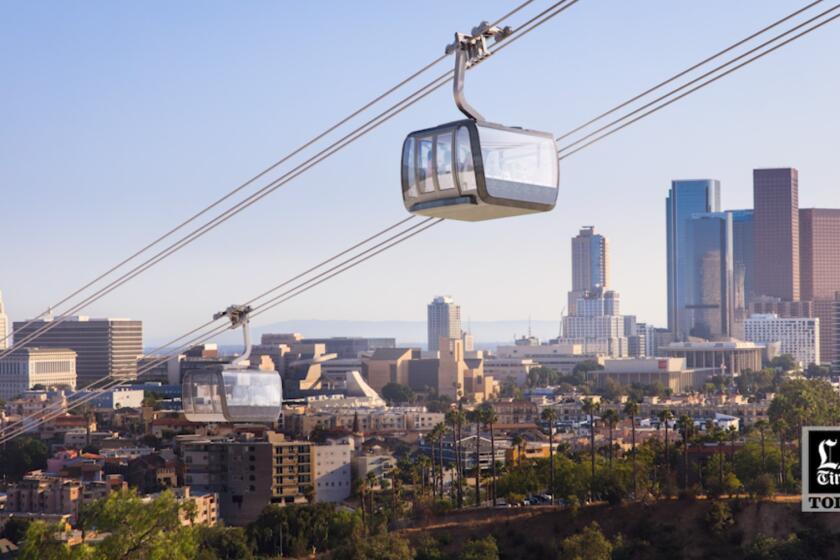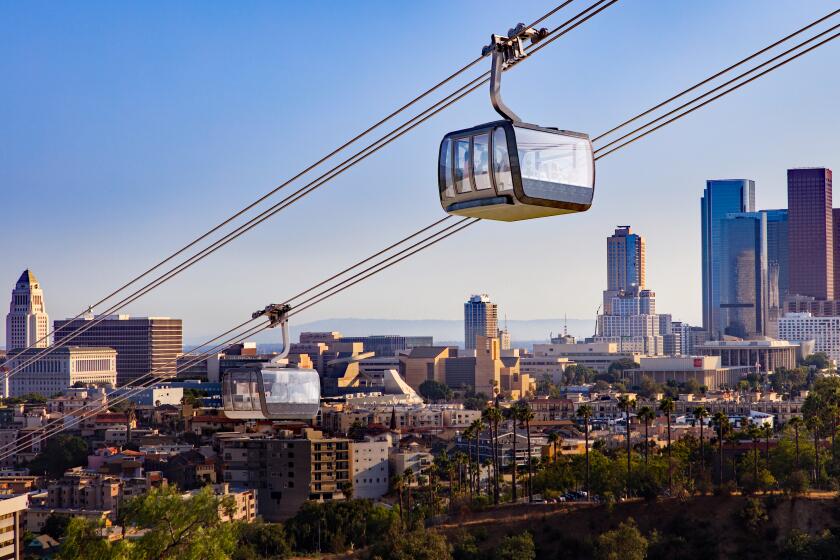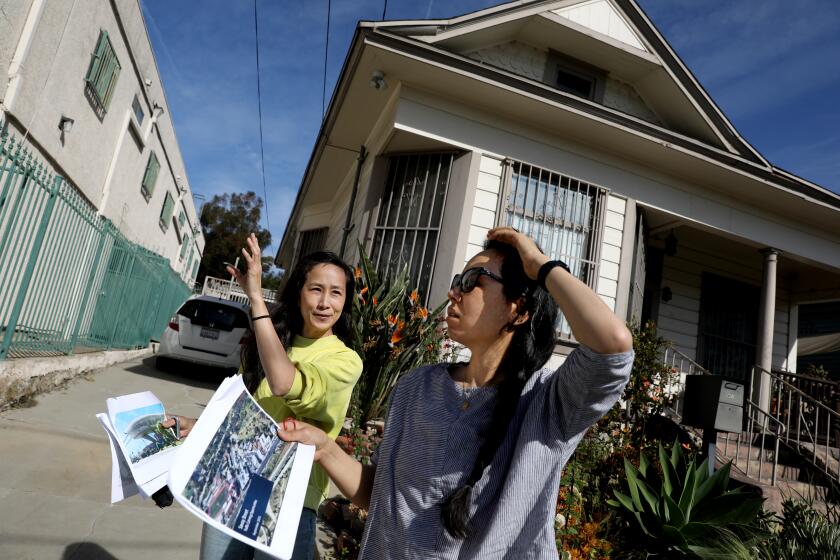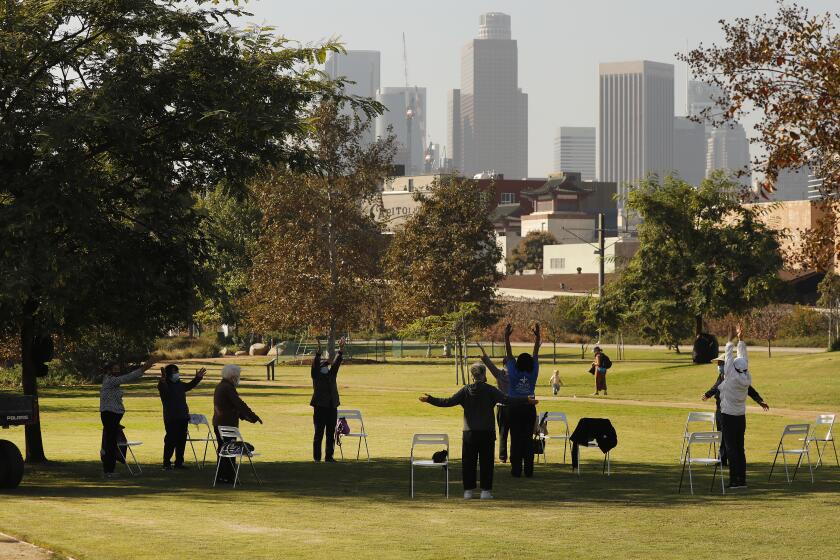Opinion: If the Dodger Stadium gondola is only the beginning, what becomes of Elysian Park?
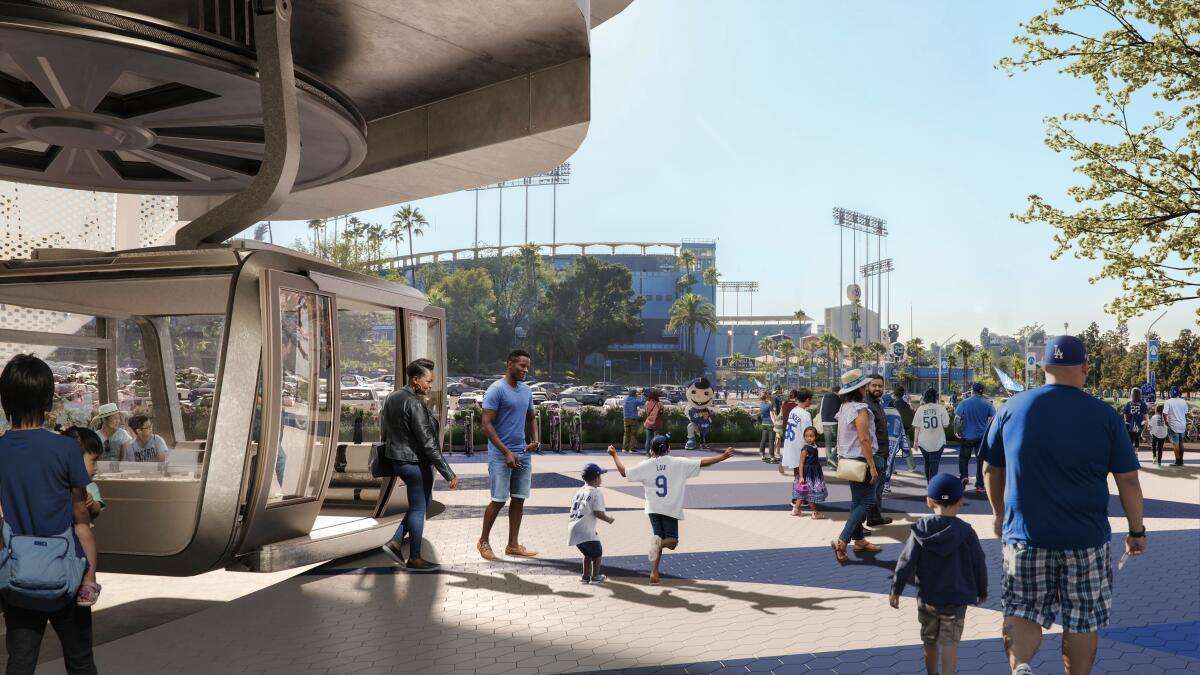
- Share via
I’m the president of the Friends of Elysian Park, a volunteer organization formed in the mid-1960s to prevent a convention center from being built in the city’s oldest public park. Since then, along with planting trees and coordinating park cleanups, we’ve managed to keep a football stadium, oil wells, a small-plane airport and other unwanted developments at bay.
Today, Elysian Park is under threat again, this time from a gondola proposed by Frank McCourt, former owner of the Dodgers, and his partner companies: Los Angeles Aerial Rapid Transit, Climate Resolve and a new nonprofit, Zero Emissions Transit. Their plan is to build the LA ART gondola from Union Station to Dodger Stadium, to ferry baseball fans to the ballpark and back while cutting down on traffic and air pollution.
Sounds like a lovely idea, right? Don’t be deceived. It’s entirely possible the gondola won’t be just a gondola. Even if it is, it will be less a dream come true than a nightmare.
A gondola from Union Station to Dodger Stadium could cost up to $500 million, and questions remain about how exactly it will get paid for.
McCourt’s project is currently under consideration by Metro, the county’s transportation agency, which will vote on a final environmental impact report perhaps as soon as this month. If the board of directors approves it, his plans will have surmounted a first crucial hurdle.
The Friends of Elysian Park strongly urge a no vote.
As The Times has reported, it’s an open secret that a gondola could very well be a precursor to a massive entertainment, retail and housing complex built in the stadium parking lots, which McCourt still owns in part. Remember: Nearly two decades ago, when he owned the team, McCourt unveiled just such a plan.
Imagine gondola riders — and cars — streaming in and out of a development similar to downtown’s L.A. Live, at all hours, 365 days a year. Elysian Park would no longer be Elysian Park, and the neighborhoods around it would also be irrevocably changed.
Former Dodgers owner Frank McCourt is hoping his Dodger Stadium gondola project will become a reality, but his proposal is meeting stiff resistance.
Even without the parking-lot complex, LA ART would have a big, negative impact. The plans, as spelled out in the final EIR, call for a futuristic, elevated passenger platform at the Union Station terminus. Built on pillars over the middle of Alameda Street across from El Pueblo de Los Angeles, the structure would obscure Union Station’s beautiful Mission Revival entrance and overshadow El Pueblo, the historic center of L.A.
Another massive “intermediate” station would be built at the southernmost entrance to Los Angeles State Historic Park, which commemorates the ancient site of a Tongva village, the campsite of the first Spanish missionaries in California, and a railway that delivered thousands of immigrants to L.A. Commercial activities in state parks are prohibited, except for the “safety, comfort and enjoyment” of park visitors; and in historic parks, such activities must be relevant to the history at hand. Does a gondola hovering overhead meet the criteria? LA ART would clear one hill in Los Angeles State Historic Park by a mere 26 feet; more than 80 mature trees would have to go.
In Chinatown, the 5-ton gondola cars — carrying about 40 riders each and most likely decorated with logos to help cover the project’s estimated $500-million price tag — would pass just 50 feet above homes and apartments. Suspended on cables from enormous 200-foot towers, the tram would follow Bishops Road past Radio Hill into the stadium parking lot.
The aerial gondola proposed for Dodger Stadium sparks fears of accelerated gentrification, and a lawsuit to stop the ‘sweetheart deal.’
Once operational, according to the EIR, the gondola could run year-round, from 6 a.m. until midnight. Ask yourself this: Why even contemplate such a schedule if the gondola is mostly meant to deliver fans to and from Dodger Stadium for 90-some home and playoff games during baseball season?
The final EIR specifically suggests that the gondola should be evaluated strictly as a transportation project. Metro “is not required to analyze a broader scheme or attribute a motive” to the plan beyond building a gondola.
In our view, the final EIR subverts the way an environmental review is supposed to work.
For example, the California Environmental Quality Act requires that environmental impact reports analyze every part of a project’s design. Yet the document Metro will vote on defers the study of the gondola’s impact on Los Angeles SHP; it’s to be done later, by California State Parks.
A company funded by former Dodgers owner Frank McCourt has proposed a $125-million gondola lift to fly customers over the park to Dodger Stadium.
CEQA also calls for a good-faith study of feasible alternatives, and, yes, the final EIR considers reconfiguring Dodger Stadium Express buses, which now run from Union Station on game days. But the comparison assumes so many constraints on the bus alternative that it seems designed to fall short. (A robust countywide park-and-ride program works well for the Hollywood Bowl.)
Finally, CEQA requires that projects aren’t considered piecemeal, with separate EIRs. But given the strong possibility that McCourt’s gondola will open the door to more development in the stadium parking lots, the final EIR hardly seems final at all.
An aerial rapid transit project from Union Station to Dodger Stadium sounds like a happy answer to Los Angeles’ traffic woes and game day gridlock. Until you look more closely. As a Trojan horse for massive development in Elysian Park, it’s a terrible idea.
Philip Murphy is the president of the Friends of Elysian Park.
More to Read
A cure for the common opinion
Get thought-provoking perspectives with our weekly newsletter.
You may occasionally receive promotional content from the Los Angeles Times.
